US-style meat smoking spices things up for Aussie weekend barbecues
By
ABC News
- Replies 12
Most weekends, Callan Buchholz wakes early, not for a morning run or a yoga class, but in pursuit of the perfect smoked brisket.
The 35-year-old lives in Rockhampton, central Queensland, a region regarded as Australia's beef capital and renowned for its bull statues and meat-related experiences.
He has joined the growing trend of weekend barbecue enthusiasts converting from the traditional Aussie barbie to American-style smoking.
It's a mouth-watering method growing in popularity both for the challenge and the cost.
"You can definitely feed a lot of people in one sitting and have food for days left over," Mr Buchholz said.
"Brisket Benny's unreal the next day for breakfast too."
Mr Buchholz said his wife, Ashleigh, got him into the culinary art of meat smoking.
"I turned 30 and I'm not into golf nor history so my wife bought me a meat smoker," he said.
"Since then, I think I've had about 15–20 mates travel with me on the journey the last few years, which is cool.
"Our text group chat is called Meat Pigs and we're always sharing pictures of our meat."
Low and slow cooking style
Meat smoking involves a slow, low-temperature cooking approach over direct heat from wood or charcoal that tenderises the meat and develops a unique smoky taste.
It takes skill and technique, but also time and patience.
"There're a few more elements at play than a traditional Australian barbecue," Mr Buchholz said.
"The prep that goes into the meat and the planning is all part and package of it."
Adelaide's Luke Leyson is a butcher, but not just any butcher.
He's captain of the Australian butcher team.
Mr Leyson said the rising trend of meat smoking had led to more demand for some types of meat.
"It's definitely translated into retail butchery," he said.
"The cuts that are used in these low-and-slow methods aren't ones you would normally come across, so as butchers we've got to move with the times as well.
"That's the best thing about these food trends. As long as we can educate ourselves and keep on top of them, it's great for us to then help out our consumers to be able to cook the perfect meat on the weekend."
The new Sunday roast
As the nation grapples with a cost-of-living crisis, Mr Leyson said a big weekend cook-up could also be more cost-effective.
He said a 12-hour smoked beef brisket was a twist on the Sunday roast.
"It's almost like that little take on your Sunday roast where you'd cook a big roast and then it would carry over into the start of the week for cold cuts," he said.
Mr Leyson said beef, pork and lamb were most popular for smoking.
"It's kind of hard not to get into the trend, especially when we've got to have a knowledge of how to cook it as well, so we can translate that to our customers.
"When you're thinking low and slow, you think of ribs and pork ribs is a good place to start."
Smoke or sizzle?
Is the traditional Aussie backyard barbecue under threat from a meat-smoking culture?
According to Australian celebrity chef Matt Golinski, there's a place for both.
He said the low-and-slow style had taken off in Australia in recent years.
"It's become a huge thing now for amateurs and professionals," he said.
"And the teams that you see getting around the countryside with their big smokers and entering competitions is an amazing thing."
"It is an art and the guys that get really serious about it, they understand the science of it."
"The temperatures are hugely important and there're the purists who will only smoke with certain woods, so there's a massive variation in the way you can achieve an end result."
The highly regarded Sunshine Coast chef said cooking and eating smoked meat offered a unique and intensely flavoured experience.
"You can really create magic," he said.
"It's also that anticipation as well, and you have to be patient enough to wait for it to be ready and once it is, it's worth that wait."
Written by Aaron Kelly, ABC News.
The 35-year-old lives in Rockhampton, central Queensland, a region regarded as Australia's beef capital and renowned for its bull statues and meat-related experiences.
He has joined the growing trend of weekend barbecue enthusiasts converting from the traditional Aussie barbie to American-style smoking.
It's a mouth-watering method growing in popularity both for the challenge and the cost.
"You can definitely feed a lot of people in one sitting and have food for days left over," Mr Buchholz said.
"Brisket Benny's unreal the next day for breakfast too."
Mr Buchholz said his wife, Ashleigh, got him into the culinary art of meat smoking.
"I turned 30 and I'm not into golf nor history so my wife bought me a meat smoker," he said.
"Since then, I think I've had about 15–20 mates travel with me on the journey the last few years, which is cool.
"Our text group chat is called Meat Pigs and we're always sharing pictures of our meat."
Low and slow cooking style
Meat smoking involves a slow, low-temperature cooking approach over direct heat from wood or charcoal that tenderises the meat and develops a unique smoky taste.
It takes skill and technique, but also time and patience.
"There're a few more elements at play than a traditional Australian barbecue," Mr Buchholz said.
"The prep that goes into the meat and the planning is all part and package of it."
Adelaide's Luke Leyson is a butcher, but not just any butcher.
He's captain of the Australian butcher team.
Mr Leyson said the rising trend of meat smoking had led to more demand for some types of meat.
"It's definitely translated into retail butchery," he said.
"The cuts that are used in these low-and-slow methods aren't ones you would normally come across, so as butchers we've got to move with the times as well.
"That's the best thing about these food trends. As long as we can educate ourselves and keep on top of them, it's great for us to then help out our consumers to be able to cook the perfect meat on the weekend."
As the nation grapples with a cost-of-living crisis, Mr Leyson said a big weekend cook-up could also be more cost-effective.
He said a 12-hour smoked beef brisket was a twist on the Sunday roast.
"It's almost like that little take on your Sunday roast where you'd cook a big roast and then it would carry over into the start of the week for cold cuts," he said.
Mr Leyson said beef, pork and lamb were most popular for smoking.
"It's kind of hard not to get into the trend, especially when we've got to have a knowledge of how to cook it as well, so we can translate that to our customers.
"When you're thinking low and slow, you think of ribs and pork ribs is a good place to start."
Smoke or sizzle?
Is the traditional Aussie backyard barbecue under threat from a meat-smoking culture?
According to Australian celebrity chef Matt Golinski, there's a place for both.
He said the low-and-slow style had taken off in Australia in recent years.
"It's become a huge thing now for amateurs and professionals," he said.
"And the teams that you see getting around the countryside with their big smokers and entering competitions is an amazing thing."
"It is an art and the guys that get really serious about it, they understand the science of it."
"The temperatures are hugely important and there're the purists who will only smoke with certain woods, so there's a massive variation in the way you can achieve an end result."
The highly regarded Sunshine Coast chef said cooking and eating smoked meat offered a unique and intensely flavoured experience.
"You can really create magic," he said.
"It's also that anticipation as well, and you have to be patient enough to wait for it to be ready and once it is, it's worth that wait."
Written by Aaron Kelly, ABC News.
















